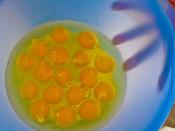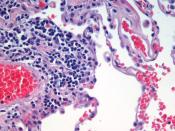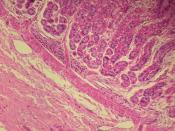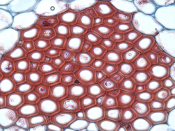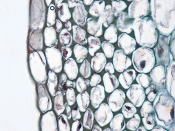Alternatives to Animal Experimentation A few years ago I was taking a college Anatomy class at my high school. We learned many things about the human body and how each body system is joined together to make life possible. In that same class I had to make a decision that not only would influence my grade, but also influence the way I looked at science. The professor explained that we would be working with animals near the end of the term. I just thought, "hey, I really want to get a jump on my college career, so I will take this class and worry about that later."ÃÂ Later came more quickly than I anticipated. Before I knew it there was this 13 lb. cat lying on a dissection tray before me. It was easier for me to complete all my dissection projects than I thought it would be. I think that the main reason for that is because this creature, just like the 8 other creatures in the room that first day of dissection, did not look like the cute little kitten I remembered from my childhood.
The concept of alternatives covers more than the replacement of animal use. In addition there are two other categories, reduction and refinement alternatives. . The Three Rs provide a strategy for a rational and stepwise approach to minimizing animal use and the suffering caused by this use, without compromising the quality of the scientific work being done, while having, as the ultimate aim, total replacement of animal models with non-animal alternatives (Monamy, 2000).
The term refinement signifies the modification of any procedures that operate from the time a laboratory animal is born until its death, so as to minimize the pain and distress experienced by the animal and enhance its well-being. Giving due consideration to issues of animal welfare is not only important from the viewpoint of ethics, it is also a matter of good science. The experience of pain and other stress is likely to result in physiological changes which may increase the variability of experimental results.
The concept of reduction alternatives covers any strategy that will result in fewer animals being used to obtain the same amount of information, or in maximizing the information obtained per animal and thus potentially limiting or avoiding the subsequent use of additional animals. There are several possible approaches that can serve to reduce the use of animals.
Replacement alternatives can be divided into four categories: computer-based systems; the use of lower organisms and embryo stages; human studies; and cell, tissue and organ cultures. Some examples of each category are given below.
Computer-based systems Computer simulations and multi-media presentations are often used to replace the use of animals in education. It is very much more difficult, and in many cases not yet possible, to simulate a truly experimental situation. In order to achieve this, a huge amount of data, usually from in vivo studies, has to be collected and integrated into the program.
Lower organisms and embryos Sometimes it is possible to conduct studies in lower organisms, such as invertebrates, plants and micro-organisms, or in vertebrates at early stages of development. Yeast cells and tobacco plant pollen tubes have been proposed for toxicity testing. Advances in genetic engineering are opening up further possibilities to replace the use of higher animals, for example by the addition of human drug-metabolizing capacity to bacterial test systems. Genetically engineered nematodes (roundworms) which carry human disease genes may prove to be useful in identifying new drugs.
Many studies on development and growth can be carried out on usually rodent embryos in vitro rather than in the pregnant mother animal. Fertilized chicken eggs are used in the HET-CAM test which predicts eye irritancy from the effects of a chemical on the chorioallantoic membrane of the egg (National Research Council, 1996) Human studies Provided that sufficient consideration is given to ethical and safety issues, studies in humans can in certain cases replace the use of animals. Pre-clinical and clinical studies in humans have long been required for the purposes of drug registration, and human volunteers are increasingly being used for the skin testing of cosmetics. Non-invasive methods of analysis, such as magnetoencephalography, nuclear magnetic resonance, electron spin resonance and positron emission topography, can be used in healthy subjects and patients to investigate disease processes.
Epidemiological studies of human populations and sub-groups can permit conclusions to be made about the relationships between exposure and disease. The potential for these types of studies is being enhanced by the identification of non-invasive or minimally-invasive biomarkers of exposure and effect. The great advantage of this approach is that it deals with human beings in their normal environments.
Cell, tissue and organ culture In many disciplines, these in vitro systems are not seen as replacement alternatives, but as the norm, especially for studies at the cellular and molecular level. In many cases they are only relative replacements, because they require freshly-obtained animal cells and tissue. However, even when freshly-isolated material is required, the animals are used more economically, because a single animal will provide tissue for a number of cultures. Human material can sometimes be used, but it can be difficult to obtain, store and distribute.
Some human tissue becomes available when it is removed during surgery. Human placenta has been suggested as a source of tissue for various types of research. For example, it contains mast cells which share certain structures with nerve cells and so can sometimes be used for neurological studies. However, whenever human tissue is used, there is always a risk that it will contain dangerous viruses (e.g. AIDS, hepatitis) and therefore greater precautions are required. The establishment of tissue banks for human tissue that is unsuitable for transplantation may offer some solutions to the problems of supply. The use of cell cultures can be more economical than the use of whole animals, once the necessary investment has been made to obtain the required equipment and expertise. Cell culture studies can often be carried out in multi-well plates in order to enable data collection to be partially or fully automated.
Because in vitro systems isolate the system under study from the rest of the organism, they are ideal for mechanistic investigations where it is desirable to avoid the confounding effects of systemic influences such as hormones. This can, however, be a disadvantage when these external factors have a crucial effect on the question being studied. There are several types of in vitro systems, each with its own advantages and disadvantages: (Monamy, 2000) Subcellular fractions of one cell component can be used for very specific studies. For example, liver microsomes are important in drug metabolism and their role can be studied in this way. However, these systems will not provide information about the influence of factors in the cell, let alone in the organ or in the whole animal/human.
Primary cell cultures are produced from fresh tissue which has been disrupted so as to obtain individual cells. Some cells are cultured in suspension, while others sink to the bottom of the vessel and attach to the plastic to form a monolayer. These cultures are fairly easy to set up, and they start with the advantage that they contain normal cells with all the characteristics that determine their specialized functions in the tissue of origin. However, they can only be maintained for a limited period of a few days, or perhaps weeks, and they tend to lose their functional capacity with time. This means that further fresh tissue is constantly required and that the cultures cannot be used for long-term studies. A further drawback is the fact that these cultures will not permit the cell-cell interactions that occur as the result of tissue architecture.
Cell line cultures consist of cells which can grow indefinitely. These cells are often derived from human or animal tumors and some have been maintained for decades. They have undergone a change known as transformation which makes them insensitive to the control mechanisms that limit the number of times normal cells can divide before dying. Cell lines can be bought in as required and a stock can be kept frozen in liquid nitrogen. They are widely used, because they are easy to maintain and do not require the use of fresh tissue. However, it has not been possible to produce cell lines from every type of tissue. .
Tissue culture avoids the loss of cell-cell interactions by the use of fragments or slices of tissue in which the architecture of the normal tissue is maintained. For example, very thin slices of liver and kidney can be used to study the possible effects of drugs on these organs. Sometimes the tissue making up one part of an organ is cultured separately, for example the proximal tubules of the kidney. These systems are still economical in their use of animals, and human tissue obtained after surgery may in some cases also be used.
However, these cultures have a limited life span and a high level of technical skill is required to set up and maintain them. In some cases, three-dimensional tissue equivalents may be used instead of tissue cultures.
These are systems in which it is possible to mimic tissue architecture by culturing cells on an artificial support matrix. A number of human skin equivalents have been developed and work is in progress on tissue equivalents for other organs.
Advances in cell culture technology may have important implications for the use of alternatives.
For example, monoclonal antibodies are increasingly used in all areas of the biosciences. However, their production in vivo is dependent on the induction of ascites tumours in mice (Singer, 1990). This is an extremely severe procedure and it results in products, the quality of which varies from batch to batch and which are potentially contaminated with animal viruses, bioreactive cytokines, or non-specific animal immunoglobulins. New developments in culture technology, such as roller cultures, membrane-based and matrix-based culture systems and hollow-fibre bioreactors enable the production of monoclonal antibodies which are of higher quality than those produced in vivo (Singer, 1990).
Everyday scientist are learning something new that will benefit the future of mankind, but with today's technology is taking the lives of animals the way? There are so many ways for scientist to get the information they need without using animals in experiments. We are close to not using animals at all for experiments, but not quite there yet, but we are headed in the right direction.
References Monamy, V. (2000). Animal Experimentation: A Guide To The Issues. Cambridge: Cambridge University Press.
Rudacille, D. (2000). The Scalpel and The Butterfly. New York: Farrar, Straus, and Giroux Dickinson, L. (1989). Victims of Vanity. Ontario: Summerhill Press. Ltd.
Institute for In Vitro Sciences: http://www.iivs.org/ Searching for Alternatives: http://www.nerdc.ufl.edu/iacue/alternatives.htm National Research Council. (1996). Guide For Care and Use of Research Animals. Washington DC: US Department of Health and Humane Services.
Singer, P. (1990). Animal Liberation, Second Edition. London: Jonathan Cape.
